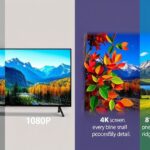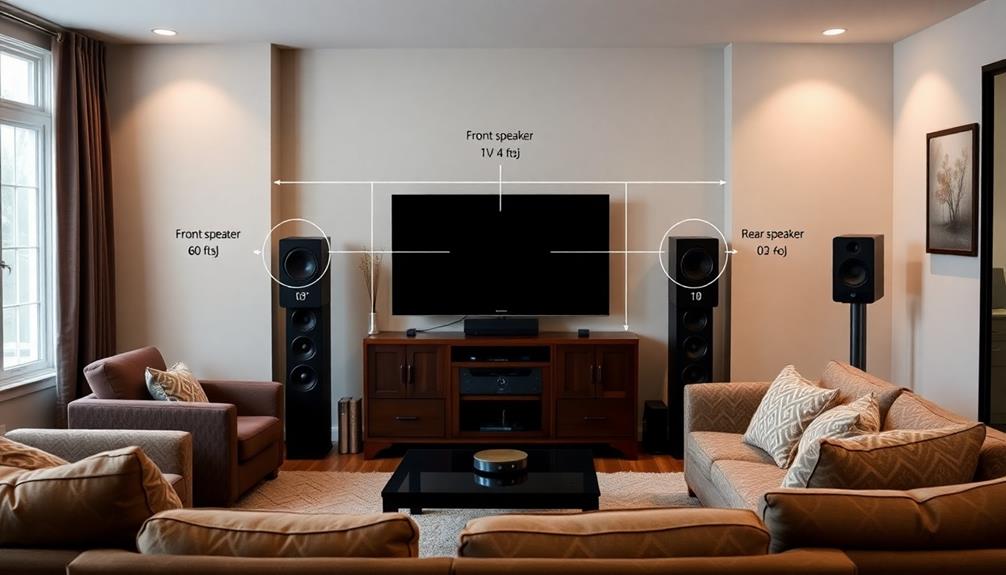Welcome to our comprehensive guide on video display standards. In this article, we will explore the different aspects of video projection, including video resolution, video formats, and display technologies. Understanding these standards is crucial for achieving optimal viewing experiences and ensuring the highest quality and clarity in videos.
Video display standards, such as video resolution and formats, play a vital role in determining the visual aspects of videos. By delving into the details and functionalities of these standards, we can better comprehend how they impact the quality and clarity of video projection. Whether you’re a content creator or a tech enthusiast, this guide will provide you with valuable insights into the world of video display standards.
Key Takeaways:
- Video display standards are essential for achieving optimal viewing experiences.
- Understanding video resolution, video formats, and display technologies is crucial for determining the quality and clarity of video projection.
- Different display technologies, such as LCD, OLED, and QLED, offer varied advantages in video playback.
- Video formats determine how video and audio data are compressed and stored.
- HDMI standards play a crucial role in high-quality video and audio transmission between devices.
The Importance of Video Resolution in Display Standards
Video resolution is a crucial factor in video display standards. It determines the level of detail and clarity in a video, impacting the overall visual experience. Different display technologies support various video resolutions, allowing viewers to enjoy content at different levels of quality. Understanding video resolution is essential for optimizing the viewing experience and making informed decisions when it comes to display technologies.

The Role of Video Resolution
Video resolution refers to the number of pixels that make up the image displayed on the screen. The higher the resolution, the more pixels are available, resulting in a sharper and more detailed image. The most common video resolutions include HD (720p), full HD (1080p), 2K (QHD), and 4K (UHD). With the emergence of 4K resolution, also known as Ultra HD, viewers can now enjoy videos with four times the detail of Full HD. The advancements in display technologies have made it possible to experience videos in stunning clarity and lifelike detail.
Display Technologies and Video Resolution
Different display technologies support various video resolutions. LCD (Liquid Crystal Display) screens, OLED (Organic Light-Emitting Diode) screens, and QLED (Quantum Dot Light Emitting Diode) screens each offer unique features and advantages. LCD screens are known for providing high-resolution images with excellent color accuracy. OLED screens, on the other hand, offer deeper black levels and better contrast, resulting in more vibrant and immersive visuals. QLED technology combines the strengths of both LCD and OLED, delivering bright and vivid images with enhanced color reproduction. These display technologies enable viewers to experience videos in their intended resolution, providing a more engaging and visually pleasing experience.
Enhancing Video Quality with HDR Technology
HDR (High Dynamic Range) technology further enhances video quality by expanding the color gamut and increasing the contrast ratio. HDR allows for a wider range of colors and a greater level of detail, resulting in more realistic and vibrant visuals. It brings out the nuances in both dark and bright areas of a video, creating a more lifelike and immersive viewing experience. HDR technology, combined with higher video resolutions, elevates the overall quality and impact of videos, allowing viewers to enjoy content in unprecedented detail and clarity.
Video resolution plays a vital role in video display standards. It determines the level of detail and clarity in a video, while display technologies and HDR technology further enhance the visual quality. By understanding the importance of video resolution and staying informed about the advancements in display technologies, we can make well-informed choices when it comes to enjoying videos with optimal visual impact.
Table: Comparison of Video Resolutions
| Video Resolution | Pixel Count | Aspect Ratio |
|---|---|---|
| HD (720p) | 1280×720 | 16:9 |
| Full HD (1080p) | 1920×1080 | 16:9 |
| 2K (QHD) | 2560×1440 | 16:9 |
| 4K (UHD) | 3840×2160 | 16:9 |
Understanding Video Formats in Display Standards
Video formats are a crucial component of video display standards. They determine how video and audio data are compressed and stored, influencing the compatibility, efficiency, and quality of video playback. Let’s dive into the different aspects of video formats and understand their significance.
Compression Formats and Codecs
Video formats utilize compression formats, also known as codecs, to reduce the size of video files without compromising quality. Popular compression formats include H.264 (also known as AVC), H.265 (also known as HEVC), and VP9. Each codec has its own strengths and weaknesses, such as efficiency, compatibility, and decoding complexity.
For example, H.264 is widely used for streaming and video playback due to its efficient compression and broad device compatibility. On the other hand, H.265 offers higher compression efficiency but requires more processing power for decoding, making it suitable for newer devices and high-resolution videos. The choice of codec depends on factors such as target device compatibility, bandwidth limitations, and desired video quality.
Container Formats
In addition to compression formats, video formats also utilize container formats to encapsulate video and audio streams into a single file. Container formats provide a standardized structure for storing multimedia data and enable compatibility across different devices and software applications.
Popular container formats include AVI, MP4, MOV, and MKV. Each format supports different combinations of video codecs, audio codecs, and additional metadata. The choice of container format depends on factors such as platform compatibility, desired features, and specific requirements of the target audience.
Choosing the Right Video Format
Choosing the right video format is crucial to ensure optimal playback compatibility and quality. It is recommended to consider factors such as target device compatibility, desired video quality, file size, and intended distribution platforms (such as web or physical media).
By selecting the appropriate video format, compression format (codec), and container format, content creators and video editors can ensure seamless playback across a wide range of devices and deliver the best viewing experience to their audience.

Table: Comparison of Popular Video Formats
| Video Format | Compression Format (Codec) | Container Format |
|---|---|---|
| AVI | Various (including MPEG-4, H.264) | AVI |
| MP4 | H.264, H.265, MPEG-4, VP9 | MPEG-4 Part 14 (.mp4) |
| MOV | H.264, H.265, MPEG-4, VP9 | QuickTime File Format (.mov) |
| MKV | H.264, H.265, MPEG-4, VP9 | Matroska Multimedia Container (.mkv) |
Display Technologies and Their Impact on Video Quality
When it comes to video display, the choice of display technology plays a crucial role in determining the overall quality of the viewing experience. Different display technologies, such as LCD, OLED, and QLED, offer unique benefits and features that can significantly impact video playback.

Table 1: Comparison of Display Technologies
| Display Technology | Advantages | Disadvantages |
|---|---|---|
| LCD (Liquid Crystal Display) | – High-resolution images – Lower cost compared to OLED – Wide range of screen sizes available |
– Limited contrast ratio – Slower response time compared to OLED |
| OLED (Organic Light-Emitting Diode) | – High contrast ratio – Deep black levels for better image quality – Faster response time compared to LCD |
– Higher cost compared to LCD – Limited screen sizes available |
| QLED (Quantum Dot Light Emitting Diode) | – Combines advantages of LCD and OLED – Enhanced color accuracy – High brightness levels |
– Limited availability of screen sizes – Higher cost compared to LCD |
In Table 1, we can see a comparison of the advantages and disadvantages of LCD, OLED, and QLED technologies. LCD screens are known for their high-resolution images and affordable prices, but they have limited contrast ratio and slower response time compared to OLED. On the other hand, OLED screens offer a high contrast ratio and deep black levels, providing better image quality. However, they tend to be more expensive and have limited screen size options. QLED technology combines the advantages of both LCD and OLED, offering enhanced color accuracy and high brightness levels, but it also comes with a higher price tag and limited availability of screen sizes.
Another display technology that has a significant impact on video quality is HDR (High Dynamic Range). HDR technology enhances the color accuracy and contrast ratio of videos, resulting in a more immersive and lifelike viewing experience. By expanding the color gamut and providing a broader dynamic range, HDR brings out details in both bright and dark areas of a video, making it particularly beneficial for content with vivid visuals and captivating cinematography.
Exploring HDMI Standards for Video Transmission
When it comes to transmitting high-quality digital video and audio between devices, HDMI (High-Definition Multimedia Interface) standards are essential. These standards ensure seamless connectivity, allowing us to enjoy our favorite videos with exceptional clarity and sound. HDMI 2.0 and HDMI 2.1 are two commonly used versions that have revolutionized the way we experience video transmission.
HDMI 2.0 is widely adopted and supports various video formats, including 4K resolution, making it perfect for modern high-definition displays. It also offers enhanced audio features, such as support for advanced audio codecs like Dolby Atmos. With HDMI 2.0, we can enjoy immersive sound and stunning visuals that bring movies, games, and other multimedia content to life.
HDMI 2.1 takes video transmission to the next level by providing even higher bandwidth capabilities. It supports up to 8K resolution, allowing for incredibly detailed and sharp images on compatible displays. Additionally, HDMI 2.1 introduces advanced features like Variable Refresh Rate (VRR) and Quick Frame Transport (QFT), which enhance the overall viewing experience, particularly for gaming enthusiasts who value smooth and lag-free gameplay.
| HDMI Standard | Supported Resolutions | Key Features |
|---|---|---|
| HDMI 2.0 | Up to 4K | Enhanced audio support, improved color depth |
| HDMI 2.1 | Up to 8K | VRR, QFT, eARC, enhanced gaming features |
With the continuous advancements in video display technologies and the ever-increasing demand for higher resolutions and immersive experiences, HDMI standards will likely continue to evolve. These standards play a vital role in shaping the future of video transmission, ensuring that we can enjoy our favorite content with the best possible quality and audiovisual performance.
The Advancements and Benefits of 4K Resolution
4K resolution has revolutionized the world of video display with its superior image quality and immersive viewing experience. With four times the pixels of full HD, 4K resolution offers incredibly sharp details, vibrant colors, and enhanced depth. This high level of detail makes 4K ideal for larger screens and cinematic viewing experiences, bringing visuals to life like never before.
One of the main advantages of 4K resolution is the flexibility it provides in video editing. With higher resolution footage, content creators can zoom in, crop, and reframe shots during post-production without sacrificing image quality. This is particularly useful for filmmakers and video editors who want to experiment with different compositions and storytelling techniques.
When combined with the latest display technologies, such as LCD, OLED, and QLED, 4K resolution delivers an even more stunning visual experience. These display technologies ensure precise color accuracy, deep blacks, and high contrast ratios, resulting in breathtaking imagery. Whether you’re watching movies, playing video games, or editing videos, the combination of 4K resolution and advanced display technologies enhances every aspect of your viewing experience.
| Advantages of 4K Resolution | Benefits |
|---|---|
| Sharper details and richer colors | Immersive viewing experience |
| Flexibility in video editing | Zooming and reframing without compromising quality |
| Enhanced visual experience with advanced display technologies | Precise color accuracy and deep blacks |
In summary, 4K resolution is a game-changer in the world of video display. Its exceptional image quality, coupled with advanced display technologies, elevates the viewing experience to new heights. With the ability to capture incredible detail and provide flexibility in video editing, 4K resolution is the preferred choice for filmmakers, content creators, and avid video enthusiasts.

Harnessing the Power of HDR Technology in Video Display
When it comes to video display, HDR (High Dynamic Range) technology is a game-changer. It revolutionizes the way videos are displayed, elevating the visual experience to new heights. HDR enhances color accuracy, brightness, and contrast ratio, resulting in a more lifelike and immersive viewing experience. By expanding the color gamut and providing a broader dynamic range, HDR brings out details in both bright and dark areas of a video, making the content more visually stunning and captivating.
Why is HDR technology so important? The answer lies in its ability to replicate real-world visuals with precision. Traditional display technologies often struggle to reproduce the full range of colors and luminance found in reality. HDR bridges this gap by enhancing the display’s ability to accurately represent the subtleties of light, shadow, and color. This technology enables viewers to see videos as they were intended to be seen by the content creators, allowing for a more immersive and engaging viewing experience.
Not all displays are created equal when it comes to HDR. To fully appreciate the benefits of this technology, it is essential to have a display that supports HDR content. HDR-certified displays offer superior color accuracy, a wider color gamut, and higher contrast ratios, ensuring that every detail of the video is showcased with exceptional clarity and realism. Whether you’re watching a nature documentary, an action-packed movie, or your favorite TV series, HDR technology enhances the visual impact and immerses you in the story like never before.
| Benefits of HDR Technology in Video Display |
|---|
| Enhanced color accuracy |
| Expanded color gamut |
| Improved contrast ratio |
| More lifelike and immersive viewing experience |
As HDR technology continues to evolve, we can expect even more exciting advancements in video display. With the increasing availability and affordability of HDR-certified displays, more viewers can enjoy the immersive experience that HDR offers. From streaming services to gaming consoles, HDR content is becoming increasingly prevalent, providing a richer and more vibrant visual experience. Through harnessing the power of HDR technology, video display is entering a new era of realism and immersion, transforming the way we consume and appreciate visual content.

The Role of Refresh Rate in Video Display Standards
In the world of video display standards, one crucial aspect that directly impacts the quality of the viewing experience is the refresh rate. Refresh rate refers to the number of times per second that a display refreshes its image. It plays a significant role in determining the smoothness of motion in videos, which is essential for creating an immersive and enjoyable viewing experience.
A higher refresh rate, such as 120Hz or 240Hz, results in smoother and more fluid video playback. This is particularly relevant in gaming, where a high refresh rate can greatly enhance the overall gaming experience by reducing motion blur and providing a more responsive and realistic feel. Whether you’re playing fast-paced action games or watching action-packed movies, a higher refresh rate ensures that the visuals remain crisp and clear even during intense scenes.
It’s important to note that the benefits of a higher refresh rate are most noticeable when paired with content that has a high frame rate. For example, a video or game running at 60 frames per second (fps) will appear smoother on a display with a 120Hz refresh rate compared to a display with a 60Hz refresh rate. However, if the content is limited to 30 fps, the difference in smoothness between a 60Hz and 120Hz display will be less pronounced.
| Refresh Rate | Motion Smoothness | Video Playback | Gaming Experience |
|---|---|---|---|
| 60Hz | Good | Satisfactory | Standard |
| 120Hz | Very Good | Smooth | Enhanced |
| 240Hz | Excellent | Ultra-Smooth | Immersive |
As the technology continues to advance, higher refresh rates are becoming more accessible and widespread. Many modern displays, especially those designed specifically for gaming or multimedia purposes, offer refresh rates of 120Hz or higher. So, if you’re looking to upgrade your display for a smoother and more immersive viewing experience, consider a monitor or TV with a high refresh rate to elevate your video playback and gaming experiences to the next level.

The Role of Refresh Rate in Gaming
When it comes to gaming, the refresh rate becomes even more crucial. A higher refresh rate not only improves the smoothness of motion but also reduces input lag, allowing for more responsive controls and quicker reaction times. This can be a game-changer, especially in competitive gaming, where split-second decisions can make all the difference between victory and defeat.
Furthermore, a higher refresh rate can prevent motion blur and ghosting, common issues that can affect the clarity of fast-moving objects in games. With a high refresh rate, you’ll be able to see every detail clearly, even during intense action sequences. This level of visual fidelity can greatly enhance your gaming experience and immerse you deeper into the virtual worlds.
In conclusion, the refresh rate is a vital component of video display standards, particularly in gaming. It directly impacts motion smoothness, video playback, and gaming experience. So, if you’re looking to elevate your viewing or gaming experience, consider investing in a display with a higher refresh rate to enjoy the benefits of smoother motion, reduced motion blur, and enhanced responsiveness.
Understanding Color Gamut in Video Display Standards
Color gamut is a crucial aspect of video display standards, as it determines the range of colors that a display can reproduce. A wider color gamut allows for more accurate and vivid color representation, resulting in a more visually appealing video experience. Two common color gamut standards used in video production and playback are DCI-P3 and Rec. 709.
DCI-P3 is a color gamut standard developed by the Digital Cinema Initiative for digital cinema projection. It offers a wider color range compared to the traditional Rec. 709 standard used for HDTV and Blu-ray. By encompassing a larger color space, DCI-P3 allows for more vibrant and realistic colors, particularly in scenes with rich hues and subtle color variations.
On the other hand, Rec. 709 is a standard color gamut used in broadcasting, home theater, and consumer displays. Although it has a narrower color range compared to DCI-P3, Rec. 709 still provides accurate color reproduction for most general viewing purposes. This standard is widely adopted and compatible with various devices and content, ensuring consistent color representation across different platforms.
| Color Gamut Standard | Description |
|---|---|
| DCI-P3 | A wide color gamut standard used in digital cinema projection, offering vibrant and realistic colors. |
| Rec. 709 | A standard color gamut used in broadcasting, home theater, and consumer displays, providing accurate color reproduction for general viewing purposes. |
When it comes to video display, color accuracy is essential for preserving the intended visual aesthetics and ensuring consistent representation across different devices. By understanding the intricacies of color gamut standards like DCI-P3 and Rec. 709, content creators and viewers can make informed decisions regarding color grading, calibration, and device compatibility, ultimately enhancing the overall video experience.
Aspect Ratio and Its Impact on Video Display
When it comes to video composition and creating a cinematic experience, the aspect ratio plays a crucial role. The aspect ratio defines the proportional relationship between a video’s width and height, shaping the visual composition and the overall viewing experience. Different aspect ratios, such as the commonly used 16:9, the classic 4:3, and the wider 21:9, offer distinct visual aesthetics and are suitable for various screen dimensions and viewing environments.
The choice of aspect ratio can greatly impact the storytelling and visual impact of a video. For instance, the widescreen 21:9 aspect ratio is often employed in cinematic productions to create a more immersive experience, as it fills the entire field of vision. On the other hand, the traditional 4:3 aspect ratio can evoke a sense of nostalgia and is commonly associated with older films and television shows.
Understanding the intended use and target audience of a video is essential in determining the appropriate aspect ratio. For example, if the video will primarily be viewed on mobile devices, a vertical aspect ratio, such as 9:16, may be more suitable to optimize the viewing experience on smaller screens. Alternatively, a square aspect ratio, like 1:1, may be preferred for social media platforms that support square videos.
Table: Comparison of Popular Aspect Ratios
| Aspect Ratio | Common Use | Characteristics |
|---|---|---|
| 16:9 | Most common for televisions, laptops, and online video platforms | Widescreen format, provides a modern and cinematic feel |
| 4:3 | Traditionally used in older television shows and films | Offers a more square-shaped frame, evokes a sense of nostalgia |
| 21:9 | Frequently used in cinematic productions and widescreen monitors | Ultra-wide format, provides an immersive viewing experience |
| 9:16 | Optimized for mobile devices and vertical video platforms | Vertical format, ideal for viewing on smaller screens |
| 1:1 | Square format commonly used in social media platforms | Symmetrical frame, suitable for platforms supporting square videos |
Choosing the right aspect ratio is an important decision for content creators as it can significantly impact the overall visual storytelling and viewer engagement. The aspect ratio sets the stage for the composition and aesthetics of the video, determining how the audience will perceive and experience the content. By understanding the characteristics and common uses of different aspect ratios, content creators can make informed decisions to create captivating videos that resonate with their target audience.
Ultimately, the aspect ratio of a video should be carefully considered to align with the desired artistic vision and the intended viewing platform. It is a powerful tool that can enhance the storytelling and create a more immersive cinematic experience. Whether it’s the wide scope of a 21:9 aspect ratio or the nostalgic charm of a 4:3 aspect ratio, each choice contributes to the overall visual impact and audience connection of a video.

The Future of Video Display Standards
As technology continues to advance at an exponential pace, the future of video display standards holds exciting possibilities. Emerging technologies such as 8K resolution, virtual reality (VR), and augmented reality (AR) are set to revolutionize the way we experience and interact with video content.
8K resolution, with its unprecedented level of detail and clarity, promises to deliver a visually stunning viewing experience. With four times the resolution of 4K, 8K provides a level of realism that immerses viewers into a whole new world of visual storytelling. As 8K displays become more affordable and widely available, content creators will have the opportunity to create breathtaking visuals that captivate audiences.
Virtual reality (VR) and augmented reality (AR) are not just buzzwords; they are technologies that have the potential to redefine the way we consume and engage with video content. VR transports viewers into virtual environments, allowing them to explore and interact with their surroundings in a fully immersive way. AR, on the other hand, overlays digital content onto the real world, enhancing our everyday experiences. From gaming to education, VR and AR have the power to revolutionize industries and create entirely new forms of entertainment.
With the rapid pace of technological advancement, the future of video display standards is undoubtedly an exciting one. As 8K resolution, VR, and AR continue to evolve and become more accessible, the possibilities for immersive and captivating video experiences are endless. From breathtaking visual effects to interactive storytelling, the future of video projection and consumption holds tremendous potential for both content creators and viewers alike.

| Emerging Technologies | Key Features |
|---|---|
| 8K Resolution | Unprecedented level of detail and clarity, four times the resolution of 4K |
| Virtual Reality (VR) | Immersive experiences, transporting viewers into virtual environments |
| Augmented Reality (AR) | Overlaying digital content onto the real world, enhancing everyday experiences |
Conclusion
Understanding video display standards is crucial for achieving an optimal viewing experience. From video resolution and formats to display technologies and aspect ratios, each element plays a vital role in the quality and visual impact of videos. By staying informed about the latest trends and advancements, we can make the most of the ever-changing world of video projection.
As technology continues to advance, video display standards will evolve, providing even more immersive and captivating video experiences. Emerging technologies like 8K resolution, virtual reality (VR), and augmented reality (AR) are shaping the future of video display, offering unprecedented levels of detail, interactivity, and immersion.
By delving into the details and functionalities of video display standards, we can better comprehend how they impact the visual aspects of videos. Whether we are content creators or viewers, staying informed about video display standards ensures that we can take full advantage of the latest technology advancements and enjoy an optimal viewing experience.
FAQ
What are video display standards?
Video display standards refer to the guidelines, resolutions, formats, and technologies that govern the quality and clarity of video projection.
What is video resolution?
Video resolution determines the level of detail and clarity in a video. It is measured in terms of pixels and can vary from standard definition (SD) to high definition (HD) and beyond.
What are the common video resolutions?
Some common video resolutions include HD (720p), full HD (1080p), 2K (QHD), and 4K (UHD). These resolutions offer varying levels of detail and image quality.
What is HDR technology?
HDR (High Dynamic Range) technology enhances the color accuracy, brightness, and contrast ratio of videos. It provides a more lifelike and immersive viewing experience by expanding the color gamut and dynamic range.
Which video formats are commonly used?
AVI, MP4, MOV, and MKV are some of the commonly used video formats. They determine how video and audio data are compressed and stored.
How do display technologies impact video quality?
Different display technologies, such as LCD, OLED, and QLED, offer varying levels of image quality, contrast, and color accuracy. They play a crucial role in enhancing the visual experience of videos.
What is the role of HDMI in video transmission?
HDMI (High-Definition Multimedia Interface) standards ensure high-quality digital video and audio transmission between devices. HDMI 2.0 and HDMI 2.1 are the most common versions used today.
What are the benefits of 4K resolution?
4K resolution offers superior image quality with four times the pixels of Full HD. It provides sharper details, richer colors, and is especially beneficial for larger screens and cinematic viewing experiences.
How does HDR technology improve video display?
HDR technology enhances color accuracy, brightness, and contrast ratio in videos. It brings out details in both bright and dark areas, resulting in a more visually appealing and immersive viewing experience.
What is the importance of refresh rate in video display?
Refresh rate refers to the number of times a display refreshes its image per second. A higher refresh rate, such as 120Hz or 240Hz, results in smoother and more fluid video playback, enhancing the overall viewing experience.
How does color gamut impact video display?
Color gamut determines the range of colors a display can reproduce. A wider color gamut allows for more accurate and vivid color representation, resulting in a more visually appealing video experience.
How does aspect ratio affect video display?
Aspect ratio defines the proportional relationship between a video’s width and height. It influences the visual composition and overall cinematic experience. Different aspect ratios serve different purposes and are suitable for various viewing environments.
What is the future of video display standards?
Emerging technologies such as 8K resolution, virtual reality (VR), and augmented reality (AR) are shaping the future of video display. These advancements offer unprecedented levels of detail, immersive experiences, and exciting possibilities for video projection and consumption.















